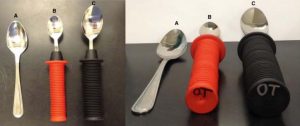6.2.3 Accommodating clients with special needs at mealtime
When it comes to special needs that can impact feeding, the issues that may need special consideration are many. We will review a few common possibilities.
Physical issues, which means the eating utensils are difficult to use due to specific diagnoses or limitations, are common, but you can make suggestions that may help using your observations. Allowing the client to have assistive devices helps the client maintain their dignity and improve their probability of receiving the nourishment required for good health.
If a client has special needs regarding mealtime, make sure you pass that information to your supervisor so the information can be added to current recommendations, Occupational Therapists can be called, supplies can be ordered and the care plan can be adjusted so the care is consistent.
Clients may have difficulty holding onto utensils and become tired from holding them too tightly, so they do not eat as much. Attachments to utensils are available to assist clients who have difficulty closing their hand and gripping the utensils. Using utensils as seen in the figure below may increase the amount of food clients eat. If these adaptive handles are not available, a washcloth may be doubled and secured with tape for that meal.

with a 3.18 cm (1.25 inch) diameter handle, and (C) a spoon with a 4.45 cm diameter handle (1.75 inch).
Clients who have hand tremors may have trouble getting the food from the plate without spilling it onto the table or floor, so plates that have raised edges may help to allow the food to be easily picked up from the plate. Using plates with high borders as displayed in the figure below may help the client pick up the food easier.

In addition to these accommodations, no-slip mats can be placed on the table to help plates stay in place while clients are attempting to feed themselves. Easy-grip, no-spill cups are available to keep clients’ liquids in the cup and maintain the warmth of the fluid.
For more examples of assistive eating devices, check out this Dining webpage from the Department of Physical and Occupational Therapy at Duke University.
If the client’s issues are due to physical limitations, you can assist to reduce the effects of the situations by insuring the clients have the needed assistive devices to help them be more independent.
If clients are visually limited, be sure to advise them of what is on the plate using the face of the clock to describe the location of each item.
If they have issues with chewing, check to see if their dentures are in or if they are fitting correctly. Make sure they are on the correct diet. Do they need a soft diet or a mechanical soft diet? If they are having difficulty chewing, offer liquids frequently and small amounts of food each time and they will need extra time to swallow.
If the client is having difficulty swallowing (dysphagia), they should be on a diet to liquify foods that are solid, and they should have observation while eating or drinking. These clients will usually need food to be pureed (blended with liquids) to provide the nutrients needed. They will also have a type of liquid thickener that can be added to liquids to make them as thick as the client needs to safely swallow. The directions for the consistency of thickened liquid must be followed exactly to avoid choking.
If the client is too tired to eat, allow them to rest and try small meals several times a day, with rest periods between.
Many people use a great deal of their energy trying to focus, control their movements and swallow at meal times. They should be assisted with getting the food to their mouths if needed to preserve energy and to supply the nutrients needed. Allow them to take as much time as possible between bites to swallow. Also, keep in mind that the client needs time after each bite to swallow, to allow the structures in the throat to close the windpipe so food does not follow the wrong path.
If the client needs help raising the spoon to their mouth to eat and they need assistance, use the hand-under-hand technique of holding their hand with the utensil in your hand and bringing it up to the mouth. This action initiates the activity and the muscle memory in the arm and hand, and the client may be more receptive to opening their mouth as a normal reaction to bringing a utensil up to their mouth to eat.
This video will show the process of the hand-under-hand technique for eating. Review the “How To Assist Another Person with Eating and Drinking” video, and try practicing this process with a volunteer to become confident in the activity.
Click here for a video transcript in .docx format: Video Transcript.
Be curious
When looking for ways to assist clients at meal times, try to think creatively when looking for ways to enhance the experience of eating for the client. Consider options when behaviours arise that seem difficult. Look for positives. There are always reasons behind actions.
Watch the following video: “Personalisation: Promoting independence in care homes”. How do the staff at this care home “think outside the box” to support Emily with her daily tea?
Click here for a video transcript in .docx format: Video Transcript.
Media Attributions
- adaptive spoons © McDonald, Levine, Richards & Aguilar is licensed under a CC BY (Attribution) license
- hospital tray © Siim Teller is licensed under a CC BY-NC-SA (Attribution NonCommercial ShareAlike) license

